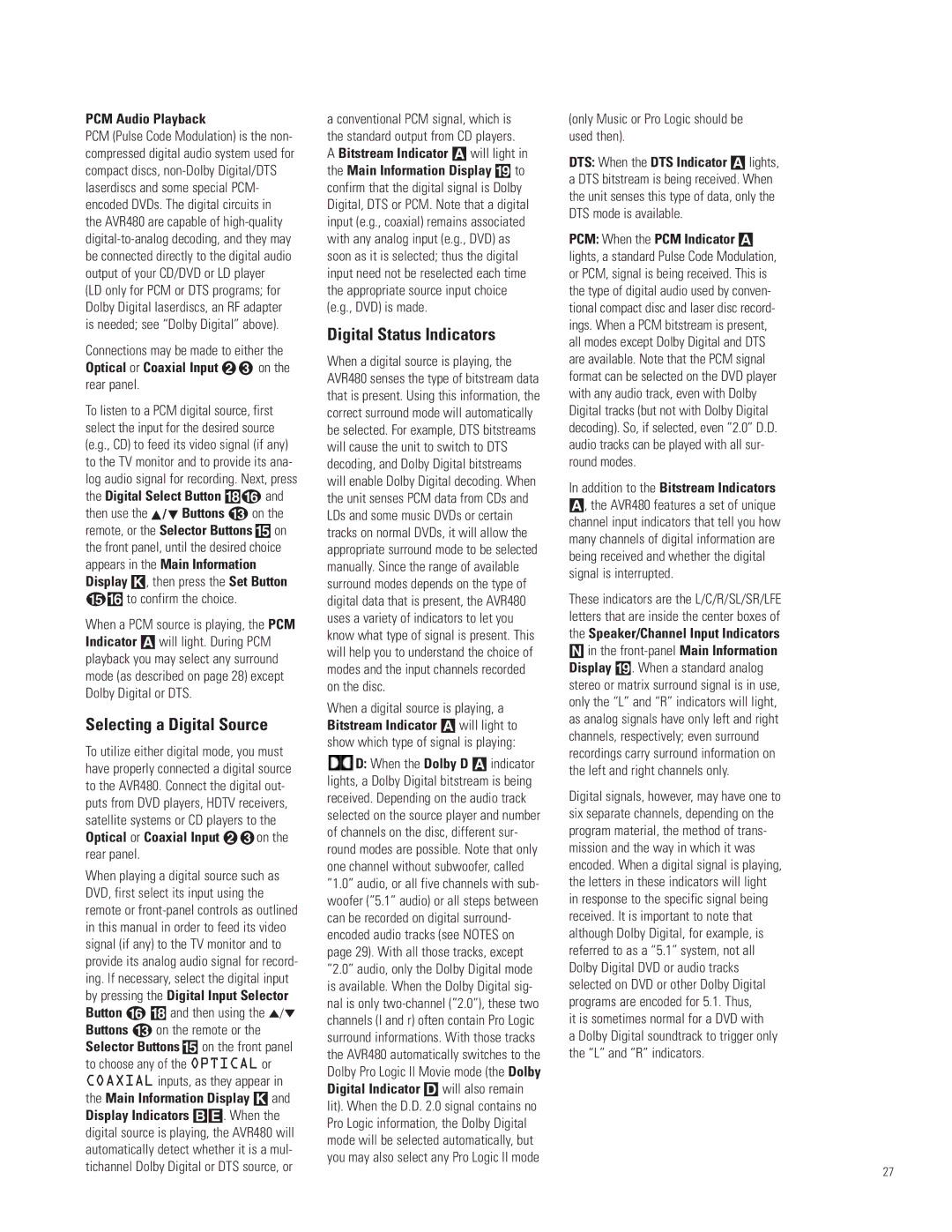PCM Audio Playback
PCM (Pulse Code Modulation) is the non- compressed digital audio system used for compact discs,
(LD only for PCM or DTS programs; for Dolby Digital laserdiscs, an RF adapter is needed; see “Dolby Digital” above).
Connections may be made to either the
Optical or Coaxial Input on the rear panel.
To listen to a PCM digital source, first select the input for the desired source (e.g., CD) to feed its video signal (if any) to the TV monitor and to provide its ana- log audio signal for recording. Next, press the Digital Select Button *F and then use the ⁄ / ¤ Buttons C on the remote, or the Selector Buttons % on the front panel, until the desired choice
appears in the Main Information
Display K, then press the Set Button E^ to confirm the choice.
When a PCM source is playing, the PCM Indicator A will light. During PCM playback you may select any surround mode (as described on page 28) except Dolby Digital or DTS.
Selecting a Digital Source
To utilize either digital mode, you must have properly connected a digital source to the AVR480. Connect the digital out- puts from DVD players, HDTV receivers, satellite systems or CD players to the
Optical or Coaxial Input on the rear panel.
When playing a digital source such as DVD, first select its input using the remote or
a conventional PCM signal, which is the standard output from CD players. A Bitstream Indicator A will light in the Main Information Display ( to confirm that the digital signal is Dolby Digital, DTS or PCM. Note that a digital input (e.g., coaxial) remains associated with any analog input (e.g., DVD) as soon as it is selected; thus the digital input need not be reselected each time the appropriate source input choice (e.g., DVD) is made.
Digital Status Indicators
When a digital source is playing, the AVR480 senses the type of bitstream data that is present. Using this information, the correct surround mode will automatically be selected. For example, DTS bitstreams will cause the unit to switch to DTS decoding, and Dolby Digital bitstreams will enable Dolby Digital decoding. When the unit senses PCM data from CDs and LDs and some music DVDs or certain tracks on normal DVDs, it will allow the appropriate surround mode to be selected manually. Since the range of available surround modes depends on the type of digital data that is present, the AVR480 uses a variety of indicators to let you know what type of signal is present. This will help you to understand the choice of modes and the input channels recorded on the disc.
When a digital source is playing, a Bitstream Indicator A will light to show which type of signal is playing:
![]() D: When the Dolby D A indicator lights, a Dolby Digital bitstream is being received. Depending on the audio track selected on the source player and number of channels on the disc, different sur- round modes are possible. Note that only one channel without subwoofer, called ”1.0” audio, or all five channels with sub- woofer (”5.1” audio) or all steps between can be recorded on digital surround- encoded audio tracks (see NOTES on page 29). With all those tracks, except ”2.0” audio, only the Dolby Digital mode is available. When the Dolby Digital sig- nal is only
D: When the Dolby D A indicator lights, a Dolby Digital bitstream is being received. Depending on the audio track selected on the source player and number of channels on the disc, different sur- round modes are possible. Note that only one channel without subwoofer, called ”1.0” audio, or all five channels with sub- woofer (”5.1” audio) or all steps between can be recorded on digital surround- encoded audio tracks (see NOTES on page 29). With all those tracks, except ”2.0” audio, only the Dolby Digital mode is available. When the Dolby Digital sig- nal is only
(only Music or Pro Logic should be used then).
DTS: When the DTS Indicator A lights, a DTS bitstream is being received. When the unit senses this type of data, only the DTS mode is available.
PCM: When the PCM Indicator A lights, a standard Pulse Code Modulation, or PCM, signal is being received. This is the type of digital audio used by conven- tional compact disc and laser disc record- ings. When a PCM bitstream is present, all modes except Dolby Digital and DTS are available. Note that the PCM signal format can be selected on the DVD player with any audio track, even with Dolby Digital tracks (but not with Dolby Digital decoding). So, if selected, even ”2.0” D.D. audio tracks can be played with all sur- round modes.
In addition to the Bitstream Indicators A, the AVR480 features a set of unique channel input indicators that tell you how many channels of digital information are being received and whether the digital signal is interrupted.
These indicators are the L/C/R/SL/SR/LFE letters that are inside the center boxes of the Speaker/Channel Input Indicators
Nin the
Digital signals, however, may have one to six separate channels, depending on the program material, the method of trans- mission and the way in which it was encoded. When a digital signal is playing, the letters in these indicators will light in response to the specific signal being received. It is important to note that although Dolby Digital, for example, is referred to as a “5.1” system, not all Dolby Digital DVD or audio tracks selected on DVD or other Dolby Digital programs are encoded for 5.1. Thus,
it is sometimes normal for a DVD with
a Dolby Digital soundtrack to trigger only the “L” and “R” indicators.
27
